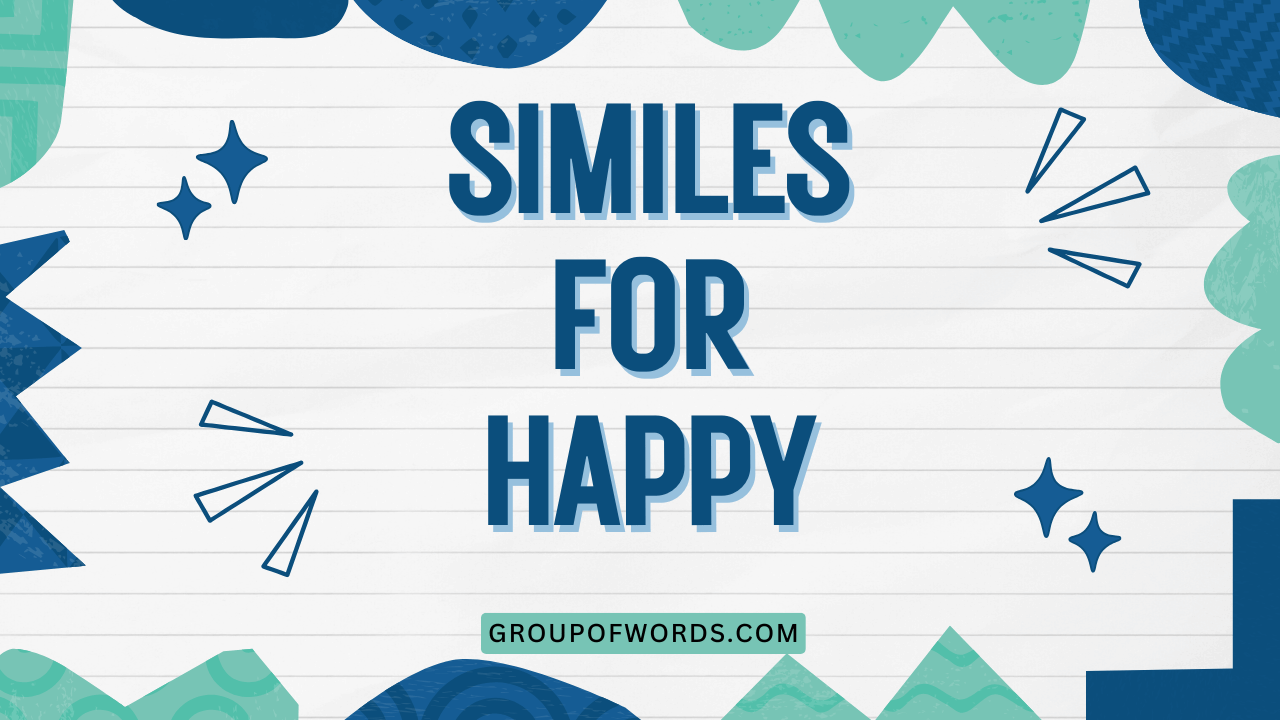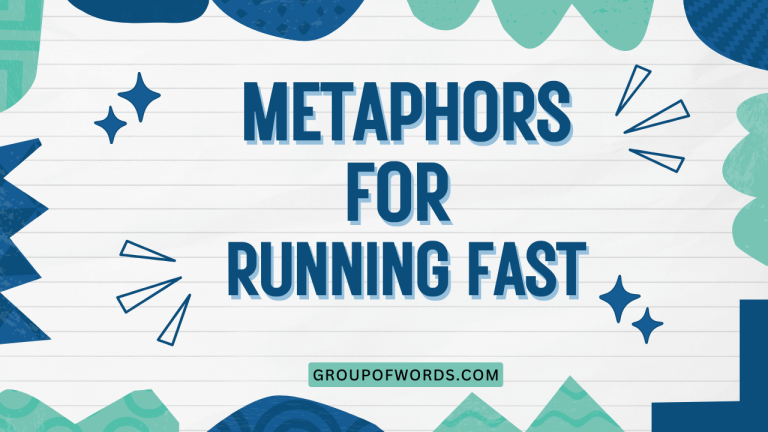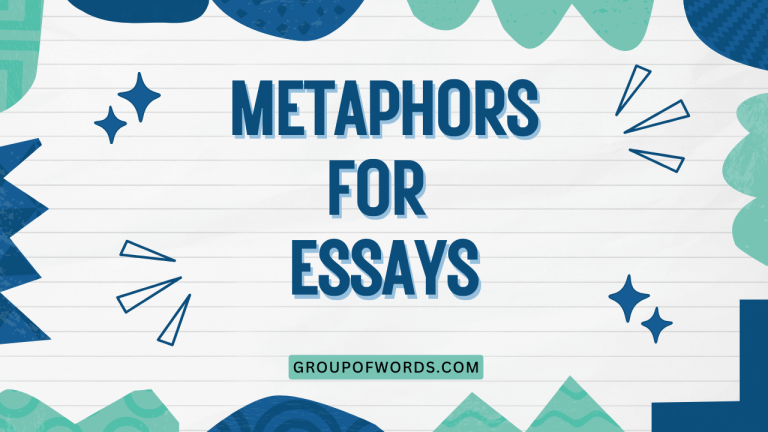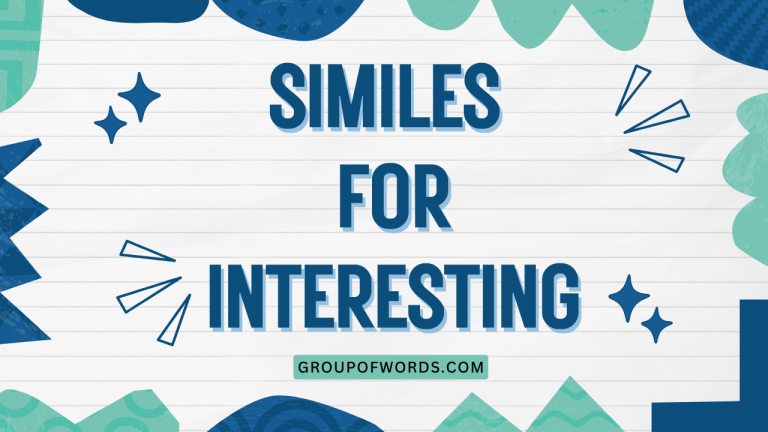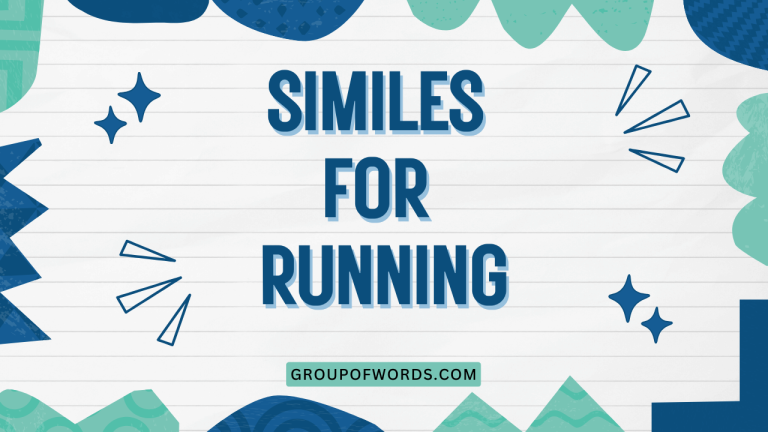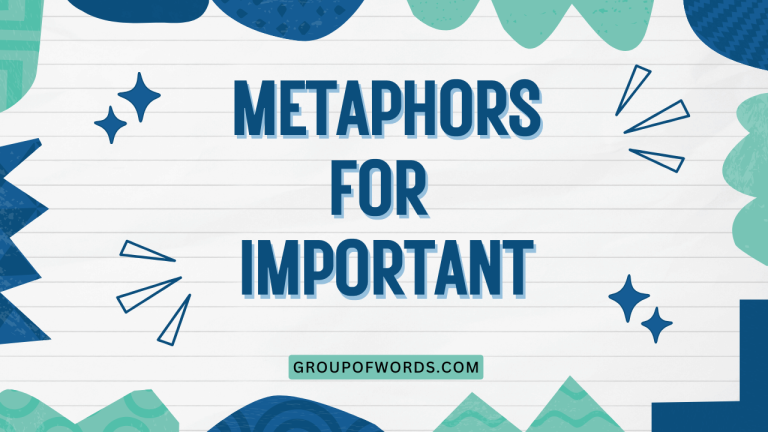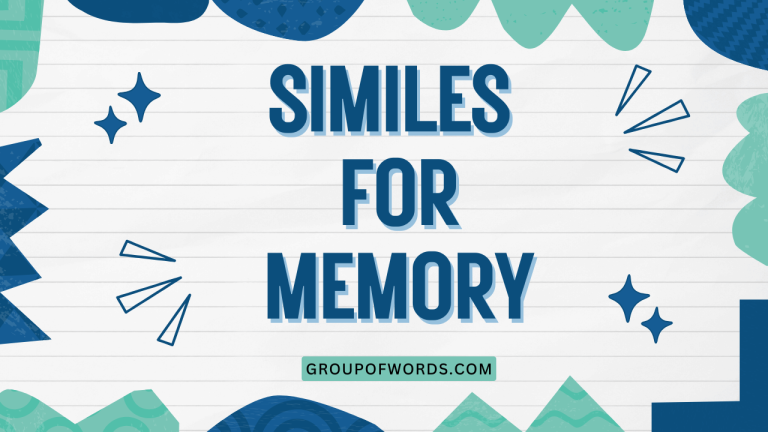Similes for Happy: Mastering Figurative Language
Understanding and using similes effectively is crucial for enhancing your writing and communication skills. Similes, which compare two unlike things using “like” or “as,” add color, depth, and vividness to your expressions.
This article focuses specifically on similes used to describe happiness, exploring various examples, structural patterns, and usage rules. Whether you are a student, writer, or language enthusiast, this guide will equip you with the knowledge and tools to use similes to express happiness in a more creative and impactful way.
This comprehensive guide is designed for English language learners of all levels, from beginners to advanced speakers. By exploring the nuances of similes for happiness, you’ll gain a deeper appreciation for figurative language and improve your ability to communicate emotions effectively.
Through detailed explanations, examples, and practice exercises, you’ll learn how to craft your own similes and understand their impact on your audience.
Table of Contents
- Introduction
- Definition of Simile
- Structural Breakdown of Similes
- Types of Similes
- Examples of Similes for Happy
- Usage Rules for Similes
- Common Mistakes with Similes
- Practice Exercises
- Advanced Topics: Nuances and Subtleties
- Frequently Asked Questions (FAQ)
- Conclusion
Definition of Simile
A simile is a figure of speech that compares two dissimilar things using the words “like” or “as.” The primary function of a simile is to create a vivid image in the reader’s or listener’s mind by drawing a comparison between something familiar and something that might be less so. Similes are a powerful tool for adding description, emotion, and emphasis to language.
Unlike metaphors, which directly state that one thing is another, similes acknowledge the comparison explicitly. This distinction is crucial because it allows for a more nuanced and subtle expression of ideas. The effectiveness of a simile lies in the strength and relevance of the comparison, making it relatable and impactful for the audience.
Similes are used extensively in literature, poetry, and everyday conversation. They serve to enhance understanding, evoke emotions, and make language more engaging.
The context in which a simile is used can significantly affect its interpretation and impact. For example, a simile used in a love poem will carry a different weight than one used in a casual conversation.
Structural Breakdown of Similes
The basic structure of a simile involves three key components: the subject, the linking word (“like” or “as”), and the object of comparison. Understanding these components is essential for creating effective and meaningful similes.
1. Subject: This is the thing being described or compared. It’s the focus of the simile. For example, in the simile “He was as happy as a clam,” the subject is “He.”
2. Linking Word: This is the word that connects the subject to the object of comparison. The most common linking words are “like” and “as.” These words indicate that a comparison is being made, rather than a direct identification.
3. Object of Comparison: This is the thing to which the subject is being compared. It should share a common characteristic with the subject, making the comparison logical and understandable. In the example above, the object of comparison is “a clam.” The implied shared characteristic is happiness or contentment.
The structural arrangement of these components can vary slightly, but the core elements remain the same. For instance, you might encounter similes that place the object of comparison before the subject for emphasis or stylistic effect.
Types of Similes
While all similes share the same basic structure, they can be categorized based on the type of comparison they make or the effect they aim to achieve. Understanding these categories can help you choose the most appropriate simile for a given situation.
Literal Similes
These similes make comparisons based on tangible, easily observable characteristics. They are often used to clarify or provide a concrete image.
Figurative Similes
These similes make comparisons based on abstract qualities or emotions. They are often used to evoke a feeling or create a deeper understanding.
Descriptive Similes
These similes focus on providing a detailed description of the subject by comparing it to something else.
Emphatic Similes
These similes are used to emphasize a particular quality or characteristic of the subject.
Examples of Similes for Happy
The following tables provide a comprehensive list of similes for expressing happiness, categorized for clarity and ease of understanding. Each category offers a unique perspective on happiness, allowing you to choose the most appropriate simile for your specific needs.
Similes Comparing Happiness to Natural Phenomena
These similes draw parallels between happiness and elements of the natural world, often evoking feelings of peace, freedom, and joy. The natural world provides a rich source of imagery for expressing happiness.
| Simile | Explanation |
|---|---|
| As happy as a lark | Larks are known for their cheerful songs, especially at dawn. |
| As happy as a clam at high tide | Clams are safest and most content when the tide is high. |
| As happy as the sun | The sun represents warmth, light, and positivity. |
| As happy as a babbling brook | The sound of a brook is often associated with tranquility and joy. |
| As happy as a bird with a French fry | A humorous take on finding unexpected joy. |
| As happy as a tree full of birds | Represents fullness and life. |
| As happy as a sunflower in the sun | Sunflowers thrive in the sun, representing growth and happiness. |
| As happy as a rainbow after the rain | Symbolizes hope and joy after a difficult time. |
| As happy as the ocean on a calm day | The ocean’s tranquility mirrors a peaceful state of mind. |
| As happy as a summer breeze | Light, carefree, and pleasant. |
| As happy as a kid in a candy store | Represents pure, unadulterated joy and excitement. |
| As happy as a pig in mud | Symbolizes contentment and enjoyment of simple pleasures. |
| As happy as a dog with two tails | An exaggerated expression of happiness. |
| As happy as a child on Christmas morning | Represents the excitement and joy of receiving gifts. |
| As happy as a lottery winner | Symbolizes unexpected and significant good fortune. |
| As happy as a newlywed couple | Represents the joy and excitement of starting a new life together. |
| As happy as a graduate on graduation day | Symbolizes the accomplishment and joy of completing a major goal. |
| As happy as a retiree on their first day of retirement | Represents freedom and relaxation after years of hard work. |
| As happy as a kid who doesn’t have to go to school | The joy of freedom and play. |
| As happy as a puppy with a bone | Simple, innocent joy. |
| As happy as a painter with a full palette | Creativity and inspiration. |
| As happy as a writer with a new idea | Excitement and potential. |
| As happy as a musician with a perfectly tuned instrument | Harmony and satisfaction. |
| As happy as a dancer on stage | Freedom of expression. |
| As happy as a chef with a perfect recipe | Achievement and delight. |
| As happy as a gardener with blooming flowers | Growth and beauty. |
| As happy as an athlete after winning a race | Victory and pride. |
| As happy as a traveler reaching their destination | Accomplishment and relief. |
Similes Comparing Happiness to Accomplishments and Success
These similes relate happiness to achieving goals, overcoming challenges, or experiencing success. They often convey a sense of pride, satisfaction, and fulfillment.
| Simile | Explanation |
|---|---|
| As happy as someone who just got a promotion | Represents career advancement and recognition. |
| As happy as a team that just won the championship | Symbolizes teamwork, effort, and victory. |
| As happy as someone who just paid off their debt | Represents financial freedom and relief. |
| As happy as an artist selling their first painting | Symbolizes validation and recognition of talent. |
| As happy as an author publishing their first book | Represents the culmination of hard work and creativity. |
| As happy as a student acing a difficult exam | Represents achievement and mastery. |
| As happy as a homeowner paying off their mortgage | Represents security and financial stability. |
| As happy as an entrepreneur launching a successful business | Symbolizes innovation, hard work, and success. |
| As happy as a scientist making a groundbreaking discovery | Represents intellectual achievement and contribution to knowledge. |
| As happy as a volunteer helping someone in need | Represents altruism and the joy of making a difference. |
| As happy as a child learning to ride a bike | Represents accomplishment and a sense of independence. |
| As happy as a traveler reaching the summit of a mountain | Symbolizes perseverance and achievement of a challenging goal. |
| As happy as a patient recovering from a serious illness | Represents relief, gratitude, and renewed appreciation for life. |
| As happy as a parent watching their child graduate | Symbolizes pride, love, and the fulfillment of parental hopes. |
| As happy as a teacher seeing their students succeed | Represents the satisfaction of making a positive impact on others. |
| As happy as a musician hearing applause after a performance | Recognition and appreciation. |
| As happy as a cook receiving compliments on their dish | Validation and enjoyment. |
| As happy as an actor taking a bow after a play | Acknowledgement and success. |
| As happy as an athlete holding the winning trophy | Victory and accomplishment. |
| As happy as a student receiving an A+ on an exam | Achievement and pride. |
| As happy as a writer completing a novel | Accomplishment and validation. |
| As happy as a painter finishing a masterpiece | Creativity and achievement. |
| As happy as a scientist making a breakthrough discovery | Innovation and contribution. |
| As happy as an inventor seeing their creation work | Ingenuity and success. |
| As happy as an entrepreneur launching a successful startup | Innovation and achievement. |
| As happy as a philanthropist making a significant donation | Generosity and impact. |
| As happy as a volunteer helping those in need | Altruism and fulfillment. |
| As happy as a mentor seeing their mentee succeed | Guidance and impact. |
Similes Comparing Happiness to Abstract Concepts
These similes link happiness to intangible ideas such as freedom, peace, and contentment. They often evoke a sense of inner joy and well-being.
| Simile | Explanation |
|---|---|
| As happy as a free bird | Represents freedom and lack of constraint. |
| As happy as peace itself | Symbolizes tranquility and harmony. |
| As happy as contentment can be | Represents pure satisfaction and well-being. |
| As happy as a clear conscience | Symbolizes moral purity and peace of mind. |
| As happy as a soul at rest | Represents inner peace and tranquility. |
| As happy as a heart filled with love | Symbolizes affection, connection, and joy. |
| As happy as a mind at ease | Represents mental clarity and relaxation. |
| As happy as a spirit soaring high | Symbolizes freedom, joy, and boundless energy. |
| As happy as a dream come true | Represents the fulfillment of hopes and aspirations. |
| As happy as a wish granted | Symbolizes the joy of receiving something desired. |
| As happy as a child’s laughter | Pure, unadulterated joy. |
| As happy as a warm embrace | Comfort and affection. |
| As happy as a heartfelt hug | Connection and warmth. |
| As happy as a loving smile | Affection and joy. |
| As happy as a tender kiss | Love and intimacy. |
| As happy as a shared secret | Intimacy and trust. |
| As happy as a fond memory | Nostalgia and joy. |
| As happy as a cherished moment | Value and appreciation. |
| As happy as a gentle touch | Affection and comfort. |
| As happy as a kind word | Support and encouragement. |
| As happy as a helping hand | Assistance and gratitude. |
| As happy as a comforting presence | Support and solace. |
| As happy as a listening ear | Understanding and empathy. |
| As happy as an open heart | Love and acceptance. |
| As happy as a generous spirit | Kindness and compassion. |
| As happy as a grateful soul | Appreciation and contentment. |
| As happy as a forgiving heart | Peace and reconciliation. |
| As happy as a hopeful outlook | Optimism and positivity. |
| As happy as inner peace | Contentment and serenity. |
Usage Rules for Similes
To use similes effectively, it’s essential to follow certain guidelines. These rules ensure that your similes are clear, relevant, and impactful.
1. Clarity: Ensure that the comparison is clear and easy to understand. The connection between the subject and the object of comparison should be obvious.
2. Relevance: The comparison should be relevant to the context and purpose of your writing or speech. A simile that is out of place or irrelevant can be confusing or distracting.
3. Originality: Strive for originality in your similes. While common similes can be effective, creating your own unique comparisons can make your writing more engaging and memorable.
4. Appropriateness: Consider the tone and audience of your writing or speech. A simile that is appropriate in one context may not be appropriate in another.
5. Avoid Clichés: Be mindful of overused similes, as they can lack impact and originality. Try to come up with fresh and unique comparisons to make your writing stand out.
6. Use Sparingly: While similes can enhance your writing, overuse can make it feel forced or artificial. Use them judiciously to achieve the desired effect.
Common Mistakes with Similes
Even experienced writers sometimes make mistakes when using similes. Being aware of these common errors can help you avoid them and improve the quality of your writing.
1. Mixing Metaphors and Similes: Confusing the direct comparison of a metaphor with the indirect comparison of a simile. Incorrect: “He was like a lion, a king among men.” Correct: “He was like a lion among men.”
2. Unclear Comparisons: Making comparisons that are vague or difficult to understand. Incorrect: “She was as happy as a thing.” Correct: “She was as happy as a child with a new toy.”
3. Illogical Comparisons: Comparing things that have no logical connection. Incorrect: “He was as happy as a rock.” Correct: “He was as happy as a person who just won the lottery.”
4. Overuse of Similes: Using too many similes in a short space, which can make the writing feel cluttered and distracting.
5. Using Clichéd Similes: Relying on overused similes that lack originality and impact. Incorrect: “As happy as a clam.” (cliché) Correct: “As happy as a clam avoiding the fisherman’s net.” (more original)
Practice Exercises
Test your understanding of similes with the following exercises. Choose the best simile to complete each sentence or create your own.
Exercise 1: Fill in the Blanks
Complete the following sentences with an appropriate simile for happiness from the list provided below.
Simile List: As happy as a lark, As happy as a clam at high tide, As happy as the sun, As happy as a babbling brook, As happy as a child on Christmas morning
| Question | Answer |
|---|---|
| 1. She was __________ when she received the acceptance letter. | As happy as a child on Christmas morning |
| 2. He felt __________ after finishing his long-term project. | As happy as a clam at high tide |
| 3. The children were __________ playing in the park. | As happy as larks |
| 4. Her laughter was __________ flowing through the room. | As happy as a babbling brook |
| 5. The warmth of their love made them __________. | As happy as the sun |
Exercise 2: Create Your Own Similes
Write your own simile for each of the following scenarios, expressing happiness.
| Scenario | Your Simile |
|---|---|
| 1. Winning a competition | As happy as an athlete holding the gold medal. |
| 2. Receiving a surprise gift | As happy as a child unwrapping a present. |
| 3. Spending time with loved ones | As happy as a family gathered around a warm fire. |
| 4. Achieving a personal goal | As happy as a mountain climber reaching the summit. |
| 5. Experiencing a beautiful sunset | As happy as an artist admiring their finished painting. |
| 6. Helping someone in need | As happy as a volunteer making a difference in the community. |
| 7. Listening to your favorite music | As happy as a dancer moving to the rhythm of the music. |
| 8. Reading a captivating book | As happy as a traveler exploring a new world. |
| 9. Eating your favorite meal | As happy as a gourmet savoring a delicious dish. |
| 10. Waking up on a sunny morning | As happy as a flower blooming in the sunlight. |
Exercise 3: Correct the Mistakes
Identify and correct the mistakes in the following sentences that contain similes.
| Incorrect Sentence | Corrected Sentence |
|---|---|
| 1. He was like a king, as tall as a tree. | He was as tall as a tree. |
| 2. She was as happy as a thing when she got the news. | She was as happy as a bird when she got the news. |
| 3. He was as happy as a rock after the rain. | He was as happy as a gardener after the rain. |
| 4. The room was filled with similes, like a dictionary. | The room was filled with joy, like a celebration. |
| 5. She was as happy as a lion, a queen among people. | She was as happy as a queen among people. |
| 6. He felt as free as a confined bird. | He felt as free as a released bird. |
| 7. The project was as easy as climbing Mount Everest. | The project was as easy as walking in the park. |
| 8. She was as calm as a hurricane. | She was as calm as a sleeping baby. |
| 9. He was as bright as a shadow. | He was as bright as a star. |
| 10. They were as united as two separate islands. | They were as united as two peas in a pod. |
Advanced Topics: Nuances and Subtleties
For advanced learners, understanding the nuances and subtleties of similes can elevate their writing to a higher level. This includes recognizing the cultural context of similes, using them for irony or satire, and creating complex, multi-layered comparisons.
Cultural Context: Similes can be deeply rooted in cultural references and experiences. A simile that resonates with one cultural group may not have the same impact on another. Being aware of these cultural nuances is crucial for effective communication.
Irony and Satire: Similes can be used ironically or satirically to create humor or critique. This involves using a simile that is intentionally incongruous or exaggerated to highlight a particular point.
Multi-layered Comparisons: Advanced writers often create similes that involve multiple layers of comparison, adding depth and complexity to their writing. This can involve comparing not just two things, but also the relationships between them.
Frequently Asked Questions (FAQ)
Here are some frequently asked questions about similes, along with detailed answers to help you deepen your understanding.
Q1: What is the difference between a simile and a metaphor?
A: The main difference lies in how the comparison is made. A simile uses “like” or “as” to make an explicit comparison, while a metaphor directly equates one thing to another without using these words.
For example, “He is like a lion” is a simile, while “He is a lion” is a metaphor.
Q2: Can a simile be a cliché?
A: Yes, a simile can become a cliché if it is overused and loses its originality. It’s best to avoid common similes like “as happy as a clam” and strive for more creative and unique comparisons.
Q3: How can I create more original similes?
A: To create original similes, think beyond the obvious and look for unexpected connections between things. Use your imagination and draw on your own experiences and observations.
The more specific and personal your similes are, the more unique they will be.
Q4: Is it possible to overuse similes in writing?
A: Yes, overuse of similes can make your writing feel cluttered and artificial. Use similes sparingly and only when they add significant value to your writing.
Too many similes can distract the reader and weaken your overall message.
Q5: How important is the choice of words in a simile?
A: The choice of words is crucial in a simile. The words you use should be precise and evocative, creating a clear and vivid image in the reader’s mind.
Pay attention to the connotations of the words you choose and make sure they align with the intended meaning of your simile.
Q6: Can similes be used in all types of writing?
A: Similes can be used in various types of writing, from poetry and fiction to essays and speeches. However, it’s important to consider the tone and purpose of your writing and use similes appropriately.
In formal or academic writing, similes should be used judiciously to add clarity and emphasis, rather than for purely decorative purposes.
Q7: What role does context play in understanding similes?
A: Context is crucial for understanding similes. The meaning and impact of a simile can vary depending on the context in which it is used.
Consider the surrounding text, the speaker or writer’s intention, and the audience’s background knowledge when interpreting a simile.
Q8: How can I improve my ability to identify and understand similes?
A: The best way to improve your ability to identify and understand similes is to read widely and pay attention to the language used by different writers. Practice identifying similes in the texts you read and analyzing their effectiveness.
You can also try creating your own similes and asking others for feedback.
Conclusion
Mastering the use of similes, particularly those expressing happiness, is a valuable skill for any English language learner. By understanding the structure, types, and usage rules of similes, you can enhance your writing and communication skills, adding depth, color, and vividness to your expressions.
Remember to be creative, original, and mindful of the context in which you use similes.
Continue practicing and experimenting with different similes to find your own unique voice and style. The more you use similes, the more natural and intuitive they will become.
With dedication and practice, you’ll be able to craft similes that effectively convey your emotions and engage your audience. Keep exploring the world of figurative language and discover the power of similes to transform your writing.
